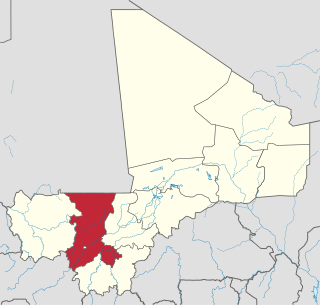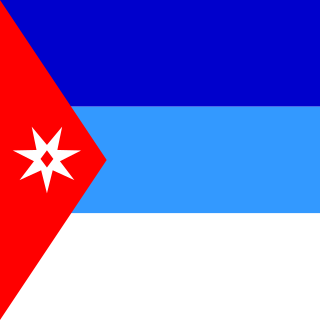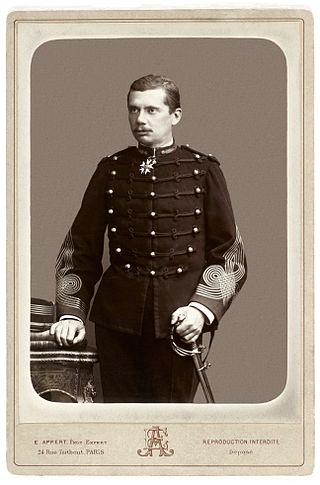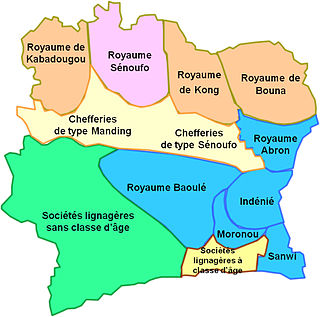
Bamako is the capital and largest city of Mali, with a 2009 population of 1,810,366 and an estimated 2022 population of 2.81 million. It is located on the Niger River, near the rapids that divide the upper and middle Niger valleys in the southwestern part of the country.

French Sudan was a French colonial territory in the Federation of French West Africa from around 1880 until 1959, when it joined the Mali Federation, and then in 1960, when it became the independent state of Mali. The colony was formally called French Sudan from 1890 until 1899 and then again from 1921 until 1958, and had a variety of different names over the course of its existence. The colony was initially established largely as a military project led by French troops, but in the mid-1890s it came under civilian administration.

Samory Toure, also known as Samori Toure, Samory Touré, or Almamy Samore Lafiya Toure, was a Muslim cleric, a military strategist, and the founder and leader of the Wassoulou Empire, an Islamic empire that was in present-day north and south-eastern Guinea and included part of north-eastern Sierra Leone, part of Mali, part of northern Côte d'Ivoire and part of southern Burkina Faso. Samori Ture was a deeply religious Muslim of the Maliki jurisprudence of Sunni Islam.

Koulikoro Region is a region in western Mali. It is the second administrative area of Mali and covers an area of 90,120 km2. Its capital is the city of Koulikoro.

The Powder River Expedition of 1865 also known as the Powder River War or Powder River Invasion, was a large and far-flung military operation of the United States Army against the Lakota Sioux, Cheyenne, and Arapaho Indians in Montana Territory and Dakota Territory. Although soldiers destroyed one Arapaho village and established Fort Connor to protect gold miners on the Bozeman Trail, the expedition is considered a failure because it failed to defeat or intimidate the Indians.

The siege of Fort Medina took place in 1857 at Médine, on the left bank of the Senegal River in present-day Mali. The Toucouleur forces of Omar Saidou Tall unsuccessfully besieged native and French colonial troops commanded by Paul Holle. After 97 days of siege, a relief force under French Governor Louis Faidherbe lifted the siege and forced the Toucouleur army to retreat.
Babemba Traoré was a king of the Kénédougou Empire. Following the 1893 death of his brother Tieba Traoré, Babemba assumed the Kénédougou throne. The capital, Sikasso, was beset at this time by both the Mandinka forces of Samory Touré and by the rapidly advancing French colonial army. The neighboring Toucouleur Empire's capital at Ségou had fallen to the French the previous year, leaving the French free to focus on subduing the Kénédougou.

The Wassoulou empire, sometimes referred to as the Mandinka Empire, was a short lived West African state that existed from roughly 1878 until 1898, although dates vary from source to source. It spanned from what is now Southwestern Mali and upper Guinea, with its capital in Bissandugu, it was moved further south and East into Northern Ghana and Cote D’ivor before its downfall.

Kouroussa or Kurussa is a town located in northeastern Guinea, and is the capital of Kouroussa Prefecture. As of 2014 it had a population of 39,611 people. A trade center and river port from at least the time of the Mali Empire, Kouroussa has long relied upon its position near the upstream limit of navigation of the Niger River to make it an important crossroads for people and goods moving between the Guinea coast and the states of the western Soudan and Niger River valley. The town and surrounding area is a center of Malinke culture, and is known for its Djembe drumming tradition.
The Mandingo Wars were a series of conflicts from 1883 to 1898 between France and the Wassoulou Empire of the Mandingo people led by Samori Ture. Comparatively, the French faced serious resistance by the Mandngos, as they were able to make use of firearms and tactics that impeded French expansion in the area. The French were ultimately triumphant and established dominance over the Ivory Coast.
The Kong Empire (1710–1898), also known as the Wattara Empire or Ouattara Empire for its founder, was a pre-colonial African Muslim state centered in northeastern Ivory Coast that also encompassed much of present-day Burkina Faso. It was founded by Dyula immigrants from the declining Mali Empire. It established a largely decentralized commercial empire based upon linkages by merchant houses protecting trade routes throughout the region. Kong rose to prominence in the 1800s as a key commercial center and center of Islamic studies. In 1898, Samori Ture attacked the city and burnt it down. Although the city was rebuilt, the Kong empire had dissipated and the French took control over the area.

Gustave Borgnis-Desbordes was a French general. He was a major figure in the French Imperial conquest of the French Sudan, modern Mali. He was Commandant-Superior of the French Military Territory of Haut-Sénégal, attached to the colonial government of Senegal, 1880 to 1883.

The Kép campaign was an important campaign in northern Vietnam during the opening months of the Sino-French War. A force of just under 3,000 French troops under the command of General François de Négrier defeated a major Chinese invasion of the Red River Delta launched by Pan Dingxin's Guangxi Army in successive engagements at Lâm, Kép and Chũ.
The Retreat from Lạng Sơn was a controversial French strategic withdrawal in Tonkin at the end of March 1885 that brought down the government of the French premier Jules Ferry and brought the Sino-French War to an end under conditions that were considered humiliating for France.
Mandinka people of Sierra Leone is a major ethnic group in Sierra Leone and a branch of the Mandinka people of West Africa. Most Sierra Leonean Mandingo are the direct descendants of Mandinka settlers from Guinea, who settled in the north and eastern part of Sierra Leone, beginning in the late 1870s to the 1890s under the rule of prominent Mandinka Muslim cleric Samori Ture. Also later a significantly large population of Mandinka from Guinea migrated and settled in Eastern Sierra Leone and Northern Sierra Leone in the early to mid 20th century. The Mandingo people of Sierra Leone have a very close friendly and allied relationship with their neighbors the Mandingo people of Guinea and Liberia, as they share pretty much identical dialect of the Mandingo language, tradition, culture and food.

The Kabadougou Kingdom was a Malinké warrior kingdom situated in north-west Côte d'Ivoire centered on the town of Odienné and bordered the Kingdom of Worodougou. It was ruled by the Touré dynasty, whose founder centered the society around slavery. The dynasty in an alliance with Samori Ture fought French colonization until 1898.
Bako Dagnon was a Malian griot singer. She is considered to be a popular representative of Mandinka culture and has released several records in local languages.
The following is a timeline of the history of the city of Bamako, Mali.

Tite Pierre Marie Adolphe Eugène Bonnier was a French soldier. He served in New Caledonia, Senegal and Tonkin. He and most of the men in his column were killed by a force of Tuaregs in a dawn massacre outside Timbuktu in what is now Mali.

Manding, Manden or even Mandé is a region located in West Africa, a space between southern Mali and eastern Guinea. It is the historic home of the Mandingo community.















